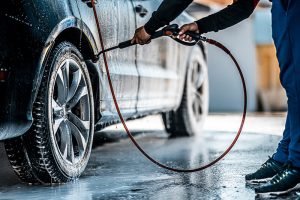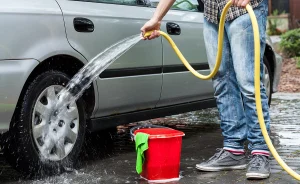DIY car washing gives you immense pleasure in creating an exquisite masterpiece on wheels. Plus, using eco-friendly methods you’ll reduce your environmental footprint!
Beginning by separating your buckets into two sections: one filled with clean soapy water for use in cleaning tasks, and the other filled with plain water to use as rinse water when rinsing sponges or mitts as you work your way from top to bottom rinsing as you go.
The Dos and Don’ts of Car Cleaning
Professional car cleaners use various tricks to reach hard-to-reach spots, which you can also utilize when cleaning your own car. A cloth over the end of a screwdriver or cotton tip can help get rid of stubborn dust in air vents or seams between cabin panels; use a lint roller on carpet and seats; and reach behind and beneath wheels with a toothbrush!
To prevent dirt particles from scratching paint surfaces, try the two bucket wash method: Fill one bucket with cleaning solution and the other with water, so that when rinsing off sponges or mitts between steps, dirty solution doesn’t mix with clean water and increase scratch risk. Grit guards may also help keep debris out of mixing in.
Assemble your car body section by section and rinse away soap residue before moving on to the next one to prevent drying before you’ve had time to finish rinsing off all areas – starting with wheels and tires (along with any panels exposed when doors are open), roof, hood, rear section of each side before finally moving to lower section of bodywork.
Preparation
Self-washing your car is an economical and effective alternative to commercial washes, providing complete control over products and methods – giving your vehicle a professional-level clean every time! Furthermore, knowing your vehicle intimately means extra attention will be given to hard-to-reach areas that might otherwise get missed at a car wash.
Before cleaning your car, carefully examine its interior to remove any personal belongings and set up your washing station by creating an adequate space and gathering basic equipment such as hoses, buckets, car shampoo, wash mitt, wheel brush and drying towels. Make sure that shaded areas are available to reduce chances of water spots caused by direct sunlight.
To protect against damage, always opt for pH-balanced car shampoo tailored for automotive use. Rinse after each pass of soap-soaping the clear coat; if encountering difficult stains like tree sap or gum, try applying some rubbing alcohol first; otherwise decluttering cup holders and cleaning regularly can prevent sticky build-up in interior spaces.
Washing
Starting the washing process requires thoroughly wetting down your car with water from a garden hose equipped with a low nozzle – as using pressure could damage its paint or finish.
Once your vehicle is wet, use quality car soap that doesn’t strip wax off with your sponge or wash mitt and begin washing the vehicle. Make sure you rinse frequently in crevices such as wheel wells and lower body.
Always start by washing your wheels first as they tend to attract dirt and grime from outside sources and are often the dirtiest. Additionally, it’s wise to do your washing under shaded conditions as direct sunlight can speed up soap drying times leaving water spots on its path to drying faster and leaving unsightly streaks behind.
Always pay particular attention to any stubborn bug and tar stains, which require using a bug and tar remover product for effective removal. Finally, ensure all soap residue has been rinsed off completely and thoroughly from your vehicle – as an extra measure, consider applying protective wax after your wash for additional safeguarding measures.
Drying
Drying may seem like a minor detail, but drying can make all the difference between an average car and a stunning one. Proper drying methods will prevent unsightly water spots as well as protect against harmful rust and corrosion damage, with high-quality drying aids being particularly effective at shortening drying times and providing your customers with smooth surfaces they expect when leaving your shop.
Rinseless washing, which completely avoids the possibility of water spots, is highly recommended. For those using traditional rinsing methods, a spray-on drying aid solution is an excellent way to break interfacial tension between water and vehicle surfaces, enabling it to evaporate more quickly.
For optimal performance, divide the vehicle into sections and spray solution evenly over each. Once towels have been saturated with solution, fold up their leading edges so they overlap with 10-15% of the vehicle before refolding them to move to another area. Blotting vehicles can also be an efficient method for drying them – Jennychem towels make excellent choices due to their size and absorbency.
Buffing
As you drive and seasons pass by, your vehicle’s paintwork becomes worn and damaged. Scratches, swirl marks and other imperfections cause its finish to dull over time; buffing can remove these scars to bring new life to its finish. Buffing requires special equipment with rotating pads containing an abrasive material – when executed correctly it provides a flawless surface.
An appropriate buffing compound for any given paint and desired result must be chosen carefully. Coarser compounds may be necessary to address deeper scratches and imperfections while finer compounds provide high gloss shines.
Build the frame for your DIY car wash using 1″ PVC pipe system. Mount four tees onto vertical pipes from behind, six 30-inch pipes connected laterally at each fitting and attach standard water hoses to each fitting – then hang colorful sponges, streamers and pool noodles from rear cross bars and front tee for a real car wash experience! Make sure all materials have been thoroughly cleaned prior to buffing as improper or excessive buffing could damage paintwork and necessitate costly repainting costs!


